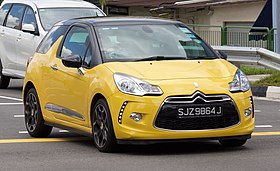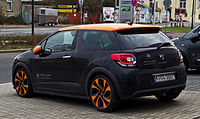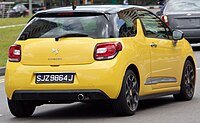DS 3
| DS 3 | |
|---|---|
 | |
| Overview | |
| Manufacturer | DS Automobiles (Citroën) |
| Also called | Citroën DS3 (until 2016) |
| Production | 2009–2016 (Citroën) 2016-present (DS) (Extended production continues in some countries) |
| Assembly | France: Poissy (PSA Poissy Plant) Malaysia: Gurun (NAM) |
| Designer | Mark Lloyd (car designer) |
| Body and chassis | |
| Class | Supermini (B) |
| Body style | 3-door convertible 3-door hatchback |
| Layout | FF layout |
| Platform | PSA PF1 platform |
| Related | Citroën C3 Citroën C4 Cactus Peugeot 208 |
| Powertrain | |
| Engine | 1.2 L I3 12v 1.4 L I4 16v 1.6 L I4 16v 1.6 L I4 THP 16v turbo 1.4 L I4 HDI turbo-diesel 1.6 L I4 HDI turbo-diesel |
| Transmission | 5-speed manual, 6-speed manual, 4-speed automatic, 6-speed automatic |
| Dimensions | |
| Length | 3,950 mm (155.5 in) |
| Width | 1,710 mm (67.3 in) |
| Height | 1,460 mm (57.5 in) |
| Chronology | |
| Predecessor | Citroën C2 Citroën C3 Pluriel (for DS3 Cabrio) |
| Successor | DS 3 Crossback} |
The DS 3 is a supermini car, produced by the French manufacturer Citroën from 2009 to 2019 and officially launched in January 2010.[1] This was the first car in the new DS range from Citroën (pronounced déesse, which is French for goddess). Its design was inspired by the concept car Citroën DS Inside.[2]
The DS3 range was facelifted in 2016, along with the DS 4 and DS 5, and relaunched without Citroën badges as part of DS Automobiles' separation from Citroën.[3]
The Citroën DS3 was named "2010 Car of the Year" by Top Gear, awarded first supermini four times in a row by the JD Power Satisfaction Survey UK[4][5][6] and second most efficient supermini (Citroën DS3 1.6 e-HDi 115 Airdream: 63.0 mpg‑imp (4.48 l/100 km)) by What Car? behind the Citroën C3.[7] In 2013, it was again the most sold premium subcompact car with 40% of these market shares in Europe.
Overview
Citroën revamped their DS3 line for the summer of 2011 with a new, limited edition model, a new colour and a new decal on the roof. The new colour is brun Hickory, a shade of dark brown that recently made its debut on the DS3's bigger sibling, the DS4. One of the DS3's strongest selling points is the ability for a customer to personalize their car when they order it by mixing and matching body and roof colours, decals, and so on. This new colour helps that by bringing the total amount of available body colours to ten.
The DS3 features prominently in the video for the Pixie Lott song "What Do You Take Me For". It is the first car that has had product placement in a British music video.[8]
The DS3 range received a mild facelift in 2014, with revised engines and new design of Xenon-LED headlights for the top of the range models.[9] The new BlueHDi diesel, available in two states of tune, has a low CO2 emissions level of 79g/km. It received a new facelift in 2016, completely dropping any reference to Citroën and its logo.
DS3 Racing
A 207 hp (154 kW) version,[10] the DS3 Racing, was introduced at the 2010 Geneva Motor Show. It is the road version of Citroën's rally specification DS3 R3. The new 0-62 mph time is 6.5 seconds and the increased top speed is 146 mph (235 km/h).
The DS3 Racing was offered in only two colours, white with gray accents or black with orange accents including roof, wheels and interior. Besides these unique colour schemes, the DS3 Racing is distinguished from other trim levels by the use of real carbon fibre on the front splitter, grill, wheel arches and rear diffuser. Additionally, carbon fibre is prominently featured on the interior.[11]
In October 2011, Citroën announced that they were planning on building a total of 2,400 DS3 Racings, significantly more than the 1,000 initially planned in 2010.[12]
Citroën DS3 WRC was used by Citroën World Rally Team in top world rallying competitions between 2011 and 2016.
DS3 Cabrio

Citroën unveiled the DS3 Cabrio at the Paris Motor Show in September 2012, with sales commencing in 2013.[13]
As a fixed profile convertible, the DS 3 retains its side bodywork, allowing for a roll back center fabric sunroof – similar to other fixed profile convertibles including the Fiat 500 (2007), Nissan Figaro (1991), Citroën 2CV (1948–1990) and the Nash Rambler Convertible "Landau" Coupe (1950).
Matière Grise edition
Citroën announced the "Matière Grise" limited edition of 750 cars for the European market. It is finished in flat grey paint with chromed mirrors, chromed door trim and chromed tail light surrounds. The roof can be ordered in either white or black and the only available wheels are 17″ alloys, also available in white and black.[14]
DS 3 facelift


In February 2016, the facelifted DS 3 was announced by DS Automobiles, as part of their separation from Citroën to become a standalone brand. The new DS 3 was launched at that year's Geneva Motor Show. The revised model no longer featured Citroën badges,[15] with the DS badge now featuring prominently on the front grille. The trim level names were also changed from DSign, DStyle and DSport and re introduced as Chic, Elegance and Prestige. An Ultra Prestige model was also added.
The facelifted model is identified by a revised front and rear design, plus the new range of PSA engines incorporating the 1.2-litre three cylinder PureTech petrol engines (available in normally aspirated 82 bhp and turbocharged 110 and 130 bhp variants), the 1.6-litre THP turbocharged petrol engine with 165 bhp, and 1.6-litre BlueHDi turbo diesel engines with 100 and 120 bhp. In addition, a new DS 3 Performance model was introduced with the THP engine uprated to 210 bhp, with a 0–100 km/h time of 6.5 seconds.
In June 2016, DS partnered with French luxury fashion and perfume company Givenchy and launched the DS 3 Givenchy Le MakeUp special edition.[16] A total of 500 Givenchy models were built and include unique features such as a textured matt white body with metallic purple roof and door mirrors, a rose pink dashboard strip and a make-up storage kit in the front central armrest. It is available with the PureTech 110 engine in manual or automatic transmission, and is based on the mid range Elegance trim level.
The DS Performance Line was launched in September 2016,[17] enabling the DS customer to have performance styling without any mechanical upgrades. DS 3 Performance Line includes aesthetics such as gloss black alloy wheels, black contrasting roof colour, exterior stripe graphics and interior coloured stitching.
Specifications
| Model | Year | Engine | Power | Torque | 0–100 km/h (0–62 mph) |
Top speed | Transmission | CO2 emission (g/km) |
|---|---|---|---|---|---|---|---|---|
| VTi 82 | 2012–present | 1199 cc I3 | 82 PS (60 kW; 81 hp) at 5,750 rpm | 118 N⋅m (87 lbf⋅ft) at 2,750 rpm | 14.2 s | 174 km/h (108 mph) | 5-speed manual | 104 |
| VTi 95 | 2009–2012 | 1397 cc I4 | 95 PS (70 kW; 94 hp) at 6,000 rpm | 135 N⋅m (100 lbf⋅ft) at 4,000 rpm | 10.6 s | 183 km/h (114 mph) | 134-136 | |
| PureTech 110 | 2015–present | 1199 cc I3 | 110 PS (81 kW; 110 hp) at 5,500 rpm | 205 N⋅m (151 lbf⋅ft) at 1,500 rpm | 9.6 s | 190 km/h (118 mph) | 104 | |
| 9.9 s | 188 km/h (117 mph) | 6-speed automatic | 108 | |||||
| VTi 120 | 2009–2015 | 1598 cc I4 | 120 PS (88 kW; 120 hp) at 6,000 rpm | 160 N⋅m (120 lbf⋅ft) at 4,200 rpm | 8.9 s | 190 km/h (118 mph) | 5-speed manual | 136-138 |
| 10.9 s | 4-speed automatic | 153-155 | ||||||
| THP 150[20] | Unknown | 1598 cc I4 turbo | 157 PS (115 kW; 155 hp) at 6,000 rpm | 240 N⋅m (180 lbf⋅ft) at 1,400-4,000 rpm | 7.3 s | 214 km/h (133 mph) | 6-speed manual | 155 |
| THP 155 | 2011?–present | 139 | ||||||
| THP 207 | 2010–2015[21][circular reference] | 207 PS (152 kW; 204 hp) at 6,000 rpm | 275 N⋅m (203 lbf⋅ft) at 2,000 rpm | 6.5 s | 235 km/h (146 mph) | 149 | ||
| THP 210 | 2016–present | 1598 cc I4 turbo | 210 PS (150 kW; 210 hp) at 6,000 rpm | 300 N⋅m (220 lbf⋅ft) at 3,000 rpm | 6.5 s | 230 km/h (143 mph) | 6-speed manual | 125 |
| Model | Year | Engine | Power | Torque | 0–100 km/h (0–62 mph) |
Top speed | Transmission | CO2 emission (g/km) |
|---|---|---|---|---|---|---|---|---|
| HDi 90 FAP | 2009–present | 1560 cc I4 turbo | 90 PS (66 kW; 89 hp) at 3,750 rpm | 230 N⋅m (170 lbf⋅ft) at 2,000 rpm | 11.3 s/11.5 s | 180 km/h (112 mph) | 5-speed manual | 104/99 |
| HDi 110 FAP | 2009–present | 110 PS (81 kW; 110 hp) at 4,000 rpm | 270 N⋅m (200 lbf⋅ft) at 2,000 rpm | 9.8 s | 118 mph (190 km/h) | 6-speed manual | 115 | |
| e-HDi 90 Airdream manual 95g | 2010?–present | 91 PS (67 kW; 90 hp) at 4,000 rpm | 230 N⋅m (170 lbf⋅ft) at 1,750 rpm | 12.5 s | 182 km/h (113 mph) | 5-speed manual | 95 | |
| e-HDi 90 Airdream manual 99g | 2010–present | 98 | ||||||
| e-HDi 110 Airdream | 2011–present | 112 PS (82 kW; 110 hp) at 3,600 rpm | 270 N⋅m (200 lbf⋅ft) at 1,750 rpm | 9.7 s | 190 km/h (118 mph) | 6-speed manual | 99 | |
| BlueHDi 120 | 2014–present | 120 PS (88 kW; 120 hp) at 3,600 rpm | 285 N⋅m (210 lbf⋅ft) at 1,750 rpm | 9.3 s | 190 km/h (118 mph) | 6-speed manual | 94 |
Safety
| Test | Points | % |
|---|---|---|
| Overall: | ||
| Adult occupant: | 31.4 | 87% |
| Child occupant: | 35.0 | 71% |
| Pedestrian: | 12.6 | 35% |
| Safety assist: | 5.8 | 83% |
| Test | Points | % |
|---|---|---|
| Overall: | ||
| Adult occupant: | 26.3 | 69% |
| Child occupant: | 18.6 | 37% |
| Pedestrian: | 23.5 | 55% |
| Safety assist: | 3.5 | 29% |
Sales and production
| Year | Worldwide Production | Worldwide sales | Difference |
|---|---|---|---|
| 2009 | 1,700[24] | 500[24] | |
| 2010 | 68,400[24] | 64,500[24] | |
| 2011 | 77,169[1] | 78,375[1] | +21,5% |
| 2012 | 68,800[25] | 68,248[25] | -13,0%[26] |
| 2013 | 68,200[27] | 69,014[27] | +1,0%[27] |
| 2014 | 57,042[28] | -17,3%[28] | |
| 2015 | 48,698[29] | -14,6%[29] | |
| 2016 | 40,653[30] | -16,5%[30] | |
| 2017 | 28,971[31] | -28,7%[31] | |
| 2018 | 16,187[32] | -44,1%[32] | |
| 2019 | 5,049[33] | -68,8%[33] |
References
- ^ a b c "PSA Annual Report 2012" (PDF). Car manufacturers. PSA. Retrieved 1 May 2013.
{{cite web}}: CS1 maint: url-status (link) - ^ Citroën DS3 Concept images and first details revealed, Global Motors, 5 February 2009
- ^ "DS brand's split from Citroën confirmed". The Telegraph. Retrieved 10 September 2014.
- ^ "Citroën DS3 first supermini in the 2012 JD Power Satisfaction Survey". JD Power. 24 May 2013. Retrieved 25 January 2017.
- ^ "Citroën DS3 first supermini in the 2013 JD Power Satisfaction Survey". The New Zealand Herald. 3 June 2013. Retrieved 25 January 2017.
- ^ "Citroën DS3 first supermini in the 2014 JD Power Satisfaction Survey". JD Power. 28 May 2014. Retrieved 28 October 2014.
- ^ "Real-world MPG: most efficient small cars". 27 October 2014. Archived from the original on 29 October 2014. Retrieved 25 January 2017.
- ^ Pixie Lott tunes in to Citroën, UK: Girlracer, 16 September 2010, archived from the original on 15 November 2010, retrieved 16 September 2010
- ^ "2014 Citroen DS3 face-lift revealed". What Car?. 22 May 2014. Retrieved 5 August 2014.
- ^ "Citroën DS3 Racing – 1.6 THP 16V Racing Black 3d – Facts & Figures". Parkers. Archived from the original on 14 May 2011. Retrieved 2 June 2011.
- ^ "Citroën DS3 Racing Review". Evo Magazine. Retrieved 24 March 2013.
- ^ "Citroën to increase DS3 Racing production?". Leftlanenews.com. Retrieved 18 October 2011.
- ^ "Citroen reveals the DS3 Cabrio". Top Gear. 31 August 2012. Retrieved 5 August 2014.
- ^ "Citroën updates the DS3 line with new limited-edition model and new colors".
- ^ "DS 3 review". Auto Express. Retrieved 9 May 2016.
- ^ "DS 3 Le MakeUp gets Givenchy makeover". Auto Express. Retrieved 1 July 2016.
- ^ "New DS Performance Line launched with sportier styling". Auto Express. Retrieved 1 September 2016.
- ^ "Citroën DS3 Technical specifications UK site". Archived from the original on 5 April 2010. Retrieved 24 March 2010.
- ^ "Citroën DS3 brochure" (PDF). Archived from the original (PDF) on 31 January 2012. Retrieved 1 May 2012.
- ^ "Citroën DS3 1.6 THP 150 6-Gang manuell Sportchic (115 kW) [10] Test Auto" (in German). Testberichte.de. Retrieved 2 June 2011.
- ^ fr:DS 3
- ^ "Euro NCAP test". Car safety tests. Euro NCAP. Retrieved 4 December 2012.
- ^ https://www.euroncap.com/en/results/ds/3/29893
- ^ a b c d "Engine specs from PSA Peugeot Citroën" (PDF). Creator and designer. PSA Peugeot Citroën. Archived from the original (PDF) on 5 June 2017. Retrieved 4 December 2012.
- ^ a b "Memento Mars 2013" (in French). PSA Peugeot Citroën. 21 February 2013: 50. Retrieved 31 July 2013.
{{cite journal}}: Cite journal requires|journal=(help)[permanent dead link] - ^ "2012 Annual results - Groupe PSA". Groupe PSA. Retrieved 9 February 2018.
- ^ a b c "2013 Annual results - Groupe PSA". Groupe PSA. Retrieved 9 February 2018.
- ^ a b "2014 Annual results - Groupe PSA". Groupe PSA. Retrieved 9 February 2018.
- ^ a b "2015 Annual results - Groupe PSA". Groupe PSA. Retrieved 9 February 2018.
- ^ a b "2016 Annual Results - Groupe PSA". Groupe PSA. Retrieved 9 February 2018.
- ^ a b "Worldwide Sales by Model and Energy 2017 - Groupe PSA". Groupe PSA. Retrieved 19 April 2018.
- ^ a b "Worldwide Sales by Model 2018". Groupe PSA. Retrieved 17 May 2019.
- ^ a b "Worldwide Sales by Models 2019". Groupe PSA. Retrieved 5 April 2020.





